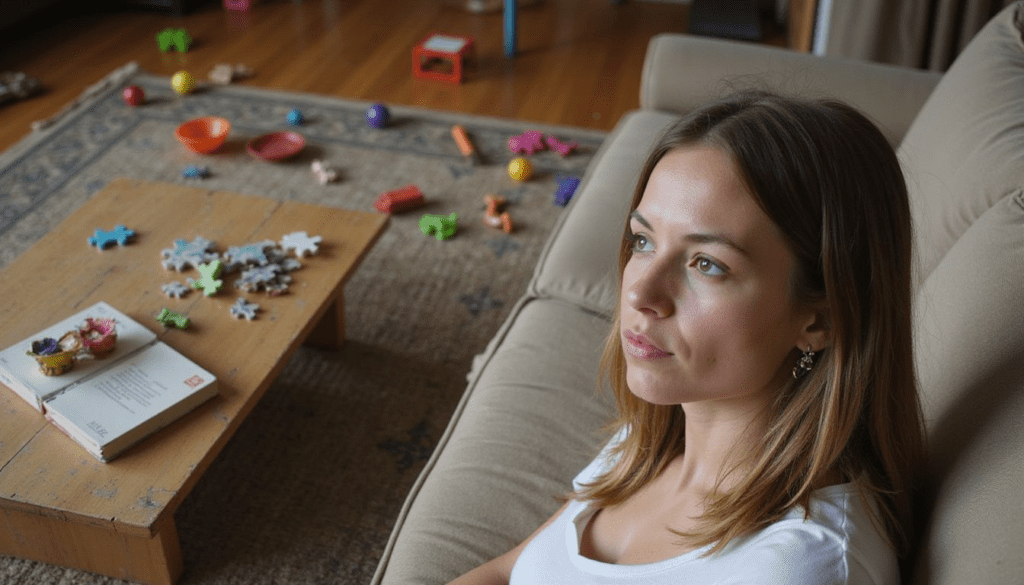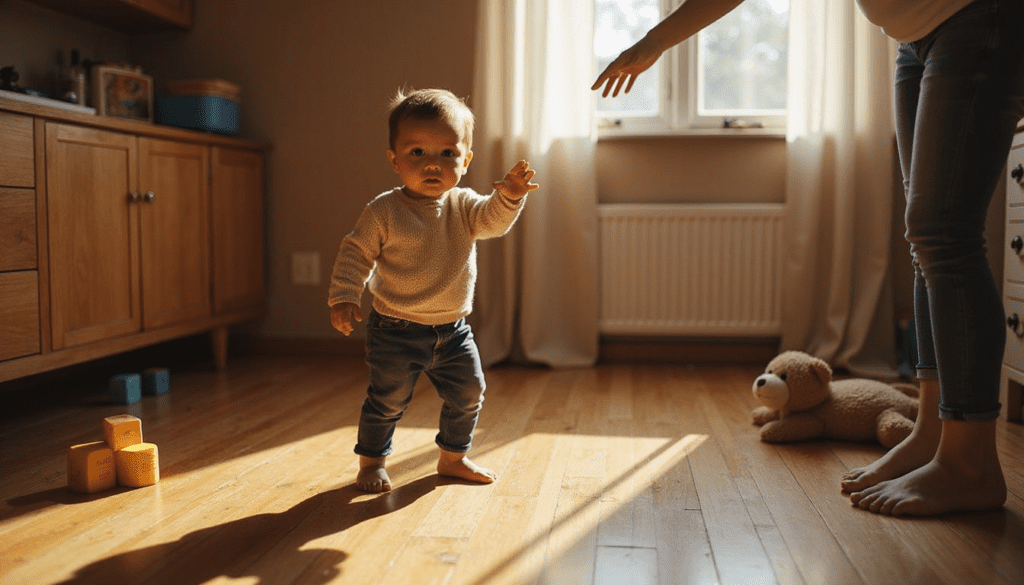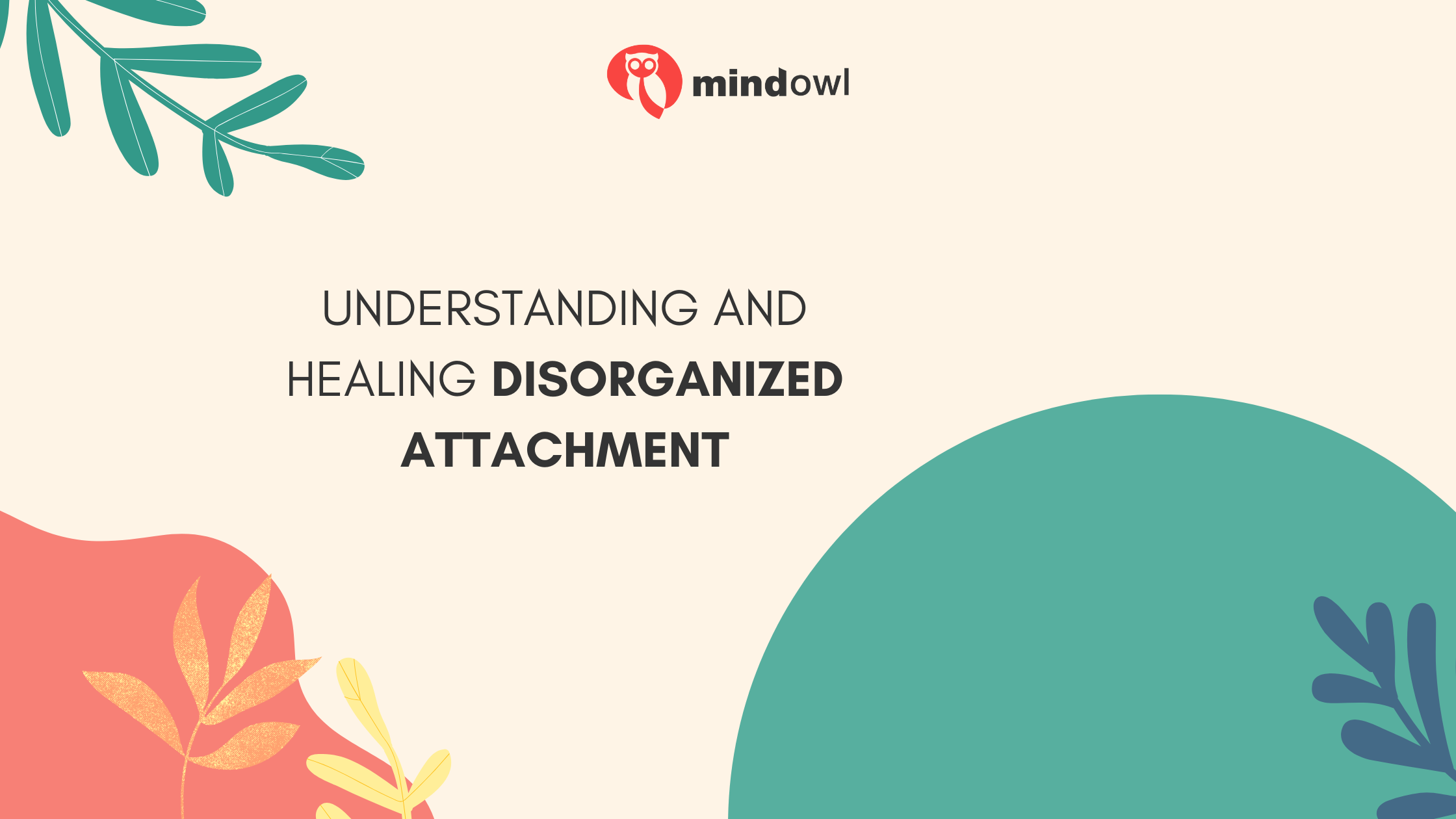
Feeling lost or confused in your relationships can feel exhausting. You may notice that you pull away from loved ones yet fear being left alone. This push and pull often leads to pain, trust issues, and confusion about how to connect with others.
Many people do not realise that disorganised attachment style could be the reason behind these mixed feelings. Research shows it develops when a child feels both drawn towards and afraid of their main caregiver.
This type of insecure attachment is linked to childhood trauma, abuse, or inconsistent caregiving.
This blog post explains what disorganised attachment style is and why it happens. You will learn the signs in children and adults, common struggles in relationships, ways to manage intense emotions, and simple coping strategies.
Practical steps for building healthier connections at home or with friends are included.
Keep reading if you want more clarity about why relationships might feel so hard sometimes.
What is Disorganised Attachment?

Disorganised attachment is one of the three insecure attachment styles described in attachment theory. Experts such as Mary Main and Judith Solomon identified this style in 1990. Disorganised or fearful-avoidant attachment often shows up as a mix of anxious and avoidant behaviours, especially in close relationships.
Children with disorganised attachment display erratic behaviour toward caregivers, sometimes seeking comfort but also acting fearful or distant.
People with a disorganised attachment style may fear both intimacy and abandonment at the same time. Traumatic or unstable childhood experiences, like inconsistent caregiving or abuse, can lead to this form of insecure attachment.
Main and Solomon called it “fright without solution” because children feel confused about whether their parent is safe or threatening. This uncertainty often carries into adult relationships, making trust and emotional closeness difficult for adults with disorganised attachments.
How Does Disorganised Attachment Develop?
Disorganised attachment often stems from childhood trauma and inconsistent caregiving. Caregivers who display fear-based behaviours can create an environment of anxiety and confusion for the child, leading to disorganised patterns in their attachment style.
Childhood trauma and inconsistent caregiving
Children who experience trauma or neglect from their main caregiver often develop a disorganised attachment style. Abuse, emotional abandonment, and psychological abuse can make the parent a source of both comfort and fear.
Mary Ainsworth’s “Strange Situation” studies reveal that children react with confusion when exposed to inconsistent parenting. Main and Solomon (1990) called this state “fright without solution.” Instead of feeling safe, the child shows mixed signals such as freezing, rapid mood changes, or odd behaviours in stressful situations.
Inconsistent caregiving disrupts emotional development and trust in others. Children cannot predict if their needs will be met which leads to attachment wounds and incoherent behaviour patterns.
This unpredictability may push them towards anxious-avoidant cycles later in life or even substance misuse for coping. The risk of developing avoidant personality disorder or borderline personality disorder rises with repeated exposure to adversity at home.
Early intervention using therapy or mindfulness techniques can help manage these attachment issues before they become deeply rooted maladaptive coping mechanisms.
Fear-based behaviours in caregivers
Fear-based behaviours in caregivers often trigger disorganised attachment in children. Caregivers may display threatening gestures, dissociation, or emotional withdrawal during stressful moments.
These actions can leave a child confused and fearful of their primary attachment figure. Submissiveness from a parent or long unexplained absences also increase these feelings of insecurity.
Children who experience unpredictable responses might show role reversal later in life. For example, they may try to comfort or manage the caregiver’s emotions instead of the other way around.
These patterns commonly appear in homes where domestic violence, substance misuse, or unresolved trauma affect the adult’s behaviour. This creates an unsafe environment that leads to disorganised attachment style and affects relationships into adulthood.
Signs of Disorganised Attachment in Children
Disorganised attachment in children shows through specific behaviours. These are signs professionals look for during assessments like the Strange Situation test.
- Children may show mixed signals. They seek comfort from their caregivers but then avoid them.
- Their behaviour towards caregivers can include aggression, which is not typical of a secure bond.
- Children might show a higher preference for strangers over their known caregivers, which is unusual.
- A child with disorganised attachment might exhibit fear without any clear reason, especially when around their caregivers.
- They often display role reversal behaviours, where they try to care for or soothe their caregiver instead of the other way around.
- Such children have a hard time being comforted; they remain distressed despite efforts to calm them down.
- Their reactions to stress are more intense compared to peers with secure attachments. They seem overly sensitive to stressors.
- Attempts at connecting or bonding with others can be inconsistent and contradictory, showing both desire for closeness and an instinctive avoidance.
Signs of Disorganised Attachment in Adults
Adults with a disorganised attachment often struggle to trust others. They may experience intense fear of abandonment, leading them to push people away. Their behaviour can be unpredictable in relationships.
One moment they seek closeness, the next they withdraw completely. Emotional dysregulation creates mood swings that are hard for them and their partners to manage. These signs impact their ability to form healthy connections and create intimacy in romantic relationships.
For more insights on managing these challenges, keep reading!
Trust issues and fear of abandonment
Trust issues often affect individuals with disorganised attachment. They desire closeness but dread it at the same time. This creates a push-pull dynamic in their relationships. People may feel intensely vulnerable, fearing rejection or abandonment.
Their heightened sensitivity to perceived rejection leads to hypervigilance. Even small signs of disinterest can trigger overwhelming emotions.
This fear impacts their ability to form secure bonds. As a result, they sometimes act inconsistently in relationships, which further distances them from others. The cycle continues as trust erodes and emotional intimacy becomes difficult for those facing these challenges.
Learning to manage these feelings requires patience and awareness, making it vital for individuals with disorganised attachment to understand their patterns and work towards healing.
Inconsistent behaviour in relationships
Adults with disorganised attachment often display inconsistent behaviour in relationships. They may show a strong desire for connection but immediately pull away when intimacy arises.
This push-and-pull dynamic creates confusion for their partners and complicates emotional bonds. Many individuals engage in self-sabotaging actions, which can lead to premature endings of relationships.
Unpredictability defines interactions for those with this attachment style. One moment they might express affection; the next, they withdraw emotionally or distance themselves physically.
Such inconsistencies hinder trust and make it difficult for them to form healthy connections with others. Those who experience these patterns often battle mental health issues, further complicating their ability to maintain stable romantic relationships.
Emotional dysregulation and mood swings
Emotional dysregulation causes intense emotions and frequent mood swings for individuals with a disorganised attachment style. They often experience sudden emotional shifts. These changes can lead to overreactions, especially when they feel rejected.
Individuals may struggle with their sense of self, worsening their emotional instability.
Unstable relationships commonly result from this emotional volatility. As intimacy grows, many individuals push others away due to fear or anxiety. This behaviour fuels an anxious-avoidant cycle in relationships, making it hard for them to connect deeply with others while managing their feelings effectively.
How Disorganised Attachment Affects Relationships
Disorganised attachment creates a cycle of anxiety and avoidance in relationships. People often struggle to trust others, leading to inconsistent behaviour that complicates emotional intimacy.
Anxious-avoidant cycles
Anxious-avoidant cycles create challenges in relationships. Individuals with a disorganised attachment style often feel torn between wanting closeness and fearing it. They may seek intimacy but quickly withdraw when they sense vulnerability.
This push-pull dynamic leads to mood swings and instability.
These cycles can exacerbate issues of trust. Overreactions to perceived rejection further complicate interactions. As a result, the desire for connection clashes with anxiety about emotional safety, creating confusion in relationships with disorganised attachments.
Emotional dysregulation makes it hard for these individuals to establish healthy boundaries or communicate effectively, trapping them in an ongoing cycle of conflict and misunderstanding.
Difficulties establishing emotional intimacy
Individuals with a disorganised attachment style often struggle to form deep emotional connections. They desire love but fear betrayal, which complicates trust in relationships. These fears create barriers that prevent open communication and vulnerability.
Many individuals avoid sharing their feelings due to the risk of disappointment or rejection.
Mood swings and push-pull dynamics add to the challenges in building intimacy. People may overanalyse their partner’s behaviour, leading to miscommunication and conflict. Supportive partners can help facilitate intimacy through clear and honest discussions.
Therapy focusing on childhood experiences also plays an important role in overcoming emotional intimacy difficulties for those affected by disorganised attachment.
Challenges with communication and boundaries
Distrust and fear make communication difficult for people with disorganised attachment. Erratic behaviours often hinder clear conversations. This can lead to misunderstandings in relationships, as individuals struggle to express their needs effectively.
Establishing healthy boundaries remains a challenge. Partners may not know where one person’s emotional space ends and another begins.
Compassion and patience become vital tools in navigating these dynamics. Practising active listening fosters better understanding between partners. Expressing needs calmly can significantly enhance relationship interactions, paving the way for healthier connections despite the impacts of disorganised attachments.
Coping Strategies for Disorganised Attachment
People can manage disorganised attachment by identifying their emotional triggers. They can practise self-regulation techniques to help control intense emotions and develop healthier relationships.
Identify emotional triggers
Emotional triggers often include signs of rejection for people with disorganised attachment. Inconsistent communication can also provoke strong reactions, making feelings of abandonment more intense.
Criticism tends to heighten emotional responses, causing anxiety and distress. Conflicting emotions towards intimacy frequently act as a trigger too. Past experiences with caregiver reliability shape these emotional responses significantly.
Understanding these triggers is essential for effective self-regulation in individuals struggling with disorganised attachment style. Awareness helps them manage their feelings and behaviours in healthy relationships better.
Practice self-regulation techniques
Recognising your attachment style is the first step in self-regulation. This awareness helps you identify emotional triggers that cause stress or anxiety. Practising mindfulness techniques can promote emotional self-regulation.
Techniques such as progressive muscle relaxation and deep breathing exercises can help manage these feelings effectively.
Engaging in open communication also aids in self-regulation. Expressing thoughts and emotions fosters connection with others, which is essential for managing disorganised attachment styles.
Building trust through consistent behaviours creates a supportive environment conducive to healing. Focus on these strategies to improve your relationships and overall well-being.
Develop self-awareness and compassion
Self-awareness helps individuals recognise how childhood experiences shape their adult behaviours. Understanding your own emotions allows for better management of triggers. Practising grounding techniques can enhance self-awareness and promote emotional regulation.
Compassion plays an essential role in healing disorganised attachment. It encourages you to treat yourself gently, especially when facing difficulties. Acknowledging unmet needs fosters a kinder view of oneself and facilitates healthier relationships with others.
Adopting these practices lays the groundwork for developing secure attachments in life and relationships.
Healing Disorganised Attachment in Adults
Adults can heal from disorganised attachment by seeking therapy or counselling. They should focus on building trust through consistent and caring behaviours. Addressing unresolved trauma also plays a key role in this healing journey.
Developing self-awareness and practising compassion helps in understanding their emotions better. Individuals can find ways to cultivate secure relationships over time. Take steps towards inner peace today, as every small effort contributes to your growth.
Seek therapy or counselling
Therapy or counselling can be a powerful tool for adults with disorganised attachment. It offers a safe space for individuals to express their feelings and needs. Trained therapists help patients understand their emotions and past trauma.
They guide clients in building trust through secure behaviours.
Utilising resources like the Disorganised Attachment Workbook can aid this healing journey. A strong support network also plays an important role in processing trauma effectively. Professional guidance often makes the path to recovery easier, allowing people to heal from an insecure attachment style and enhance their relationships.
Build trust through secure behaviours
Building trust requires consistent, secure behaviours. Show emotional availability in your interactions. Foster open and honest communication with others. Make a conscious effort to practise patience; this can help you navigate difficult situations better.
Setting healthy boundaries also plays a key role in establishing security.
Professional support can aid adults with disorganised attachment as they learn new ways to build trust. Therapy enables individuals to recognise their behaviour patterns and transform them into more secure actions.
By committing to personal development, people create healthier dynamics in relationships and reduce the risk of emotional abandonment or fear of intimacy.
Address and process unresolved trauma
Processing unresolved trauma is essential for healing disorganised attachment. Therapy offers effective routes, including psychodynamic therapy, cognitive behavioural therapy (CBT), and eye movement desensitisation and reprocessing (EMDR).
These methods guide individuals to confront their past traumas in a safe environment.
Mindfulness practices can also play a significant role. Techniques like meditation or deep breathing help individuals manage stress and emotions. Building a support network further aids this journey, as talking with friends or therapists fosters understanding and connection.
Developing self-awareness cultivates compassion for oneself during the healing process.
Supporting Someone with Disorganised Attachment
Support someone with disorganised attachment by fostering open conversations. Encourage them to share their feelings without judgment.
Encourage open and honest communication
Encouraging open and honest communication builds trust. Clear communication reduces confusion. People with disorganised attachment often feel anxious in relationships. They need a safe space to express their feelings and needs.
Active listening creates understanding, while mindful physical touch can enhance connection.
Use facial expressions and eye contact to convey safety. These elements help individuals feel more comfortable sharing their thoughts. The “Perfectly Imperfect” exercise allows reflection on personal influences, promoting deeper conversations about emotions in relationships.
Setting healthy boundaries also fosters an environment where individuals can communicate freely without fear of judgement or rejection.
Set healthy boundaries
Setting healthy boundaries is essential for improving relationship dynamics, especially with someone who has a disorganised attachment style. Partners must express their needs calmly and clearly.
This practice enhances communication and reduces misunderstandings. Healthy boundaries also contribute to emotional health by ensuring that both individuals feel safe and respected.
Studies show that people with disorganised attachment often have the lowest tolerance for intrusions into their personal space. Establishing these limits can help manage feelings of anxiety or fear related to closeness in intimate relationships.
Therapy can support partners in overcoming challenges around setting boundaries effectively, promoting healthier interactions overall.
Practice patience and empathy
Practising patience and empathy can make a significant difference for someone with disorganised attachment. Listening without rushing helps build trust. This approach allows individuals to express their emotions safely.
Supportive relationships foster emotional resilience, enabling growth.
Understanding unpredictable behaviours requires time and compassion. Those who struggle with emotional regulation benefit from empathetic interactions. A therapeutic alliance built on these principles encourages healing.
Therapists can provide a space where clients practise these important skills, leading to more secure connections in their relationships.
Conclusion
Understanding disorganised attachment offers significant insights into our emotional lives. This complex style impacts relationships and personal wellbeing profoundly. Recognising its signs helps us tackle issues effectively.
Recovery from disorganised attachment is achievable through therapy, self-awareness, and establishing trust. With the right support, individuals can lead healthier and more fulfilling lives.
References
- https://www.simplypsychology.org/disorganized-attachment.html (2024-03-11)
- https://www.attachmentproject.com/blog/disorganized-attachment/
- https://www.relationalpsych.group/articles/disorganized-attachment-style-understanding-its-impact-and-healing (2024-06-25)
- https://www.verywellmind.com/disorganized-attachment-in-relationships-7500701 (2023-06-20)
- https://www.attachmentproject.com/disorganized-attachment-relationships/
- https://goodhealthpsych.com/blog/disorganized-attachment-in-adults-how-it-affects-relationships-and-trust/
- https://www.attachmentproject.com/blog/self-regulation-disorganized-attachment-triggers/
- https://counselingcentergroup.com/secure-versus-disorganized-attachment/ (2024-06-10)
- https://resources.soundstrue.com/blog/helping-someone-with-a-disorganized-attachment-style/ (2019-05-28)
- https://positivepsychology.com/disorganized-attachment/ (2024-05-10)
MindOwl Founder – My own struggles in life have led me to this path of understanding the human condition. I graduated with a bachelor’s degree in philosophy before completing a master’s degree in psychology at Regent’s University London. I then completed a postgraduate diploma in philosophical counselling before being trained in ACT (Acceptance and commitment therapy).
I’ve spent the last eight years studying the encounter of meditative practices with modern psychology.

